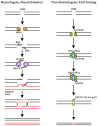Emerging Perspectives on DNA Double-strand Breaks in Neurodegenerative Diseases
- PMID: 31362659
- PMCID: PMC7057204
- DOI: 10.2174/1570159X17666190726115623
Emerging Perspectives on DNA Double-strand Breaks in Neurodegenerative Diseases
Abstract
DNA double-strand breaks (DSBs) are common events that were recognized as one of the most toxic lesions in eukaryotic cells. DSBs are widely involved in many physiological processes such as V(D)J recombination, meiotic recombination, DNA replication and transcription. Deregulation of DSBs has been reported in multiple diseases in human beings, such as the neurodegenerative diseases, with which the underlying mechanisms are needed to be illustrated. Here, we reviewed the recent insights into the dysfunction of DSB formation and repair, contributing to the pathogenesis of neurodegenerative disorders including Alzheimer's disease (AD), amyotrophic lateral sclerosis (ALS), Huntington's disease (HD) and ataxia telangiectasia (A-T).
Keywords: DNA double-strand breaks; alzheimer’s disease; amyotrophic lateral sclerosis; apoptosis; histone modifications; huntington’s disease; neurodegenerative diseases..
Copyright© Bentham Science Publishers; For any queries, please email at epub@benthamscience.net.
Figures


Similar articles
-
DNA Double Strand Breaks: A Common Theme in Neurodegenerative Diseases.Curr Alzheimer Res. 2016;13(11):1208-1218. doi: 10.2174/1567205013666160401114915. Curr Alzheimer Res. 2016. PMID: 27033054 Review.
-
DNA double-strand breaks: a potential therapeutic target for neurodegenerative diseases.Chromosome Res. 2019 Dec;27(4):345-364. doi: 10.1007/s10577-019-09617-x. Epub 2019 Nov 9. Chromosome Res. 2019. PMID: 31707536 Free PMC article. Review.
-
DNA repair deficiency in neurodegeneration.Prog Neurobiol. 2011 Jul;94(2):166-200. doi: 10.1016/j.pneurobio.2011.04.013. Epub 2011 Apr 30. Prog Neurobiol. 2011. PMID: 21550379 Free PMC article. Review.
-
Oxidative stress and mitochondrial dysfunction-linked neurodegenerative disorders.Neurol Res. 2017 Jan;39(1):73-82. doi: 10.1080/01616412.2016.1251711. Epub 2016 Nov 3. Neurol Res. 2017. PMID: 27809706 Review.
-
Common Factors in Neurodegeneration: A Meta-Study Revealing Shared Patterns on a Multi-Omics Scale.Cells. 2020 Dec 8;9(12):2642. doi: 10.3390/cells9122642. Cells. 2020. PMID: 33302607 Free PMC article.
Cited by
-
Cytosolic DNA sensors and glial responses to endogenous DNA.Front Immunol. 2023 Mar 14;14:1130172. doi: 10.3389/fimmu.2023.1130172. eCollection 2023. Front Immunol. 2023. PMID: 36999037 Free PMC article. Review.
-
cGAS Mediates the Inflammatory Responses of Human Microglial Cells to Genotoxic DNA Damage.Inflammation. 2024 Apr;47(2):822-836. doi: 10.1007/s10753-023-01946-8. Epub 2023 Dec 26. Inflammation. 2024. PMID: 38148453 Free PMC article.
-
Therapeutic approaches targeting aging and cellular senescence in Huntington's disease.CNS Neurosci Ther. 2024 Oct;30(10):e70053. doi: 10.1111/cns.70053. CNS Neurosci Ther. 2024. PMID: 39428700 Free PMC article. Review.
-
Mobile circular DNAs regulating memory and communication in CNS neurons.Front Mol Neurosci. 2023 Dec 6;16:1304667. doi: 10.3389/fnmol.2023.1304667. eCollection 2023. Front Mol Neurosci. 2023. PMID: 38125007 Free PMC article.
-
Circulating Cell Free DNA and DNA Double-Strand Breakage in Alzheimer's Disease.J Alzheimers Dis Rep. 2024 Apr 8;8(1):627-635. doi: 10.3233/ADR-240012. eCollection 2024. J Alzheimers Dis Rep. 2024. PMID: 38746625 Free PMC article. Review.
References
-
- Papamichos-Chronakis M., Peterson C.L. Chromatin and the genome integrity network. Nat. Rev. Genet. 2013;14(1):62–75. [http://dx.doi.org/10.1038/nrg3345]. [PMID: 23247436]. - PMC - PubMed
-
- Jackson S.P., Bartek J. The DNA-damage response in human biology and disease. Nature. 2009;461(7267):1071–1078. [http://dx.doi.org/10.1038/nature08467]. [PMID: 19847258]. - PMC - PubMed
-
- Akematsu T., Fukuda Y., Garg J., Fillingham J.S., Pearlman R.E., Loidl J. Post-meiotic DNA double-strand breaks occur in Tetrahymena, and require Topoisomerase II and Spo11. eLife. 2017;6:6. [http://dx.doi.org/10.7554/eLife.26176]. [PMID: 28621664]. - PMC - PubMed
-
- Khan F.A., Ali S.O. Physiological roles of DNA double-strand breaks. J. Nucleic Acids. 2017;2017:6439169. [http://dx.doi.org/10.1155/2017/6439169]. [PMID: 29181194]. - PMC - PubMed
-
- Taleei R., Girard P.M., Nikjoo H. DSB repair model for mammalian cells in early S and G1 phases of the cell cycle: Application to damage induced by ionizing radiation of different quality. Mutat. Res. Genet. Toxicol. Environ. Mutagen. 2015;779:5–14. [http://dx.doi.org/10.1016/j.mrgentox.2015.01.007]. [PMID: 25813721]. - PubMed
Publication types
MeSH terms
LinkOut - more resources
Full Text Sources
Medical
Miscellaneous

